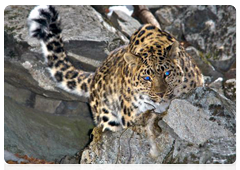MULTIMEDIA
 +
+
The Far Eastern leopard prefers areas of high relief, with steep hill slopes, rock outcrops and watersheds
 +
+
The Far Eastern leopard is the northernmost leopard subspecies, found north of the 45th parallel. These days, it can be found only in the southwest of the Primorye Territory
 +
+
The maximum body length is 136 centimetres in males and 112 centimetres in females; the length of tails is 90 and 73 centimetres, respectively; the maximum weight is 60 kilogrammes
 +
+
The Far Eastern leopard’s biology has already been studied in-depth, yet further efforts are needed to find out more about the species’ capability to adapt to the changing environment
 +
+
Leopard newborns are blind, and have thick, long fur. Their skin is covered with small, solid brownish and black spots, with no rosettes. At birth, they weigh 500 to 700 grammes, on average, and measure 15 centimeters in length
 +
+
Far Eastern leopards become sexually mature by the age of 2.5 to 3, males usually a bit later than females
 +
+
Sergei Ivanov delivers the keynote speech on the conservation of the Far Eastern leopard at a St Petersburg session of the Russian Geographic Society’s Board of Trustees
 +
+
The Far Eastern leopard programme has entered a new phase after two months of exploration across southwestern regions of the Primorye Territory, with existing camera traps checked and new ones installed
 +
+
According to the most optimistic estimates, the world’s Far Eastern leopard population is 40, with 30 leopards presumably dwelling in the Primprye Territory, and the remaining ten in China
 +
+
Unless emergency conservation measures are taken, the leopard population will go extinct. With this in mind, a strategy was enacted in Russia in 1999 to save the Far Eastern leopard
 +
+
Leopard hunting was officially banned in 1956, but the expansion of agriculture, especially reindeer breeding, in leopard-populated areas destabilised the population
 +
+
Russia’s Nikolai Przhevalsky and Mikhail Yankovsky are the first researchers to have provided information about the Far Eastern leopard. They mentioned this species in their expedition notes
 +
+
China plans to set up nine frontier preserves for the Far Eastern leopard and the Amur tiger in the next few years
 +
+
Leopards’ life expectancy in the wild is 10 to 15 years, while in captivity they can live up to 20 years








 ABOUT THE PROGRAMME
ABOUT THE PROGRAMME
 FAR EASTERN LEOPARD RESEARCH: A HISTORY
FAR EASTERN LEOPARD RESEARCH: A HISTORY
 FAR EASTERN LEOPARD: LIFE, BEHAVIOUR AND MORE
FAR EASTERN LEOPARD: LIFE, BEHAVIOUR AND MORE
 SERGEY IVANOV'S VISIT
SERGEY IVANOV'S VISIT
 NEWS
NEWS
 MULTIMEDIA
MULTIMEDIA